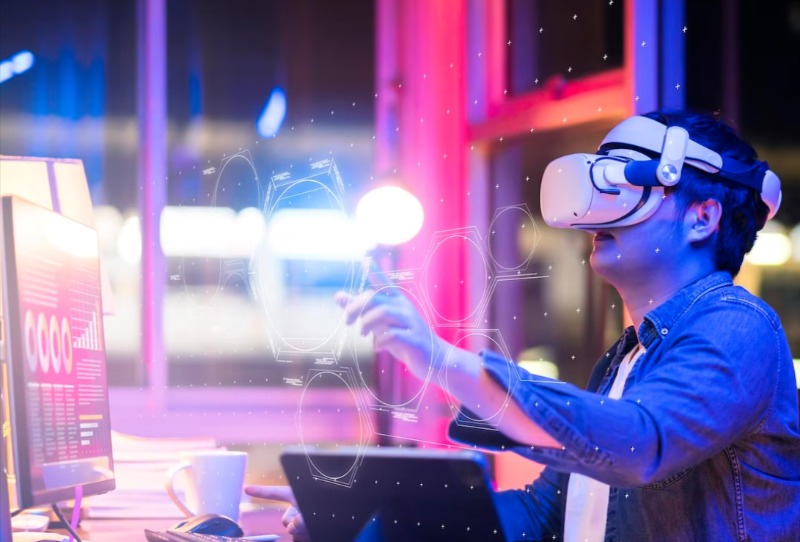
Creating Immersive User Experiences with 3D and AR in Front-End Development
- Post
- August 9, 2023
- Front-End Frameworks, Front-End Tips & Tricks, Web Development
- 0 Comments
In the rapidly evolving landscape of web development, creating immersive user experiences has become a paramount goal for front-end developers. The integration of 3D and Augmented Reality (AR) technologies has opened up a new realm of possibilities, allowing designers and developers to craft captivating and interactive interfaces that engage users in unprecedented ways. In this comprehensive guide, we delve into the fusion of 3D and AR with front-end development, unraveling the principles, strategies, and tips to craft remarkable digital experiences.
Understanding the Power of 3D and AR in Front-End Design
In the world of front-end design, 3D and AR technologies have emerged as potent tools to transform static interfaces into dynamic, interactive spaces. 3D elements add depth and realism, while AR overlays digital content onto the real world, enhancing user engagement. Leveraging these technologies requires a blend of creativity and technical prowess, enabling developers to forge connections between the virtual and physical realms seamlessly.
Incorporating 3D and AR: Front-End Developer Tips
Designing for Depth and Dimensionality
Integrating 3D elements into front-end layouts introduces depth and dimensionality, enhancing visual appeal. By meticulously considering the placement and perspective of 3D objects, developers can guide users’ focus and create a sense of immersion.
Optimizing Performance for Seamless Interactivity
While 3D and AR experiences can captivate users, performance remains critical. Compressing 3D assets, minimizing network requests, and employing lazy loading are essential techniques to ensure smooth interactions and quick loading times.
Ensuring Cross-Browser and Device Compatibility
Compatibility is paramount in the diverse landscape of web browsing. Employ progressive enhancement and feature detection to provide a consistent experience across various browsers and devices.
Intuitive AR Integrations
AR enriches real-world environments with digital content. To ensure a seamless experience, focus on accurate tracking, intuitive interactions, and providing meaningful context within the AR interface.
Blending 3D and 2D Elements
Achieve harmony between 3D and 2D elements by balancing their visual weight and ensuring that the interface remains coherent and user-friendly.
Front-End Design Principles for Immersive Experiences
User-Centric Approach
Prioritize user needs and behaviors when integrating 3D and AR elements. Craft experiences that align with user expectations and lead to meaningful interactions.
Storytelling through Interaction
Use 3D and AR to narrate stories and convey information interactively. Create scenarios that unfold as users engage with the interface, enhancing engagement and comprehension.
Visual Hierarchy and Focal Points
Leverage 3D to guide users’ attention toward focal points, emphasizing important elements and enhancing the overall user journey.
Realism and Authenticity
Strive for authenticity in 3D and AR representations. Realistic textures, lighting, and physics can create a more believable and engaging environment.
Seamless Transitions and Animations
Smooth transitions and animations enhance the fluidity of interactions, making the user experience more enjoyable and intuitive.
The Front-End Design Process with 3D and AR Integration
Conceptualization and Ideation
Begin by brainstorming ideas that leverage 3D and AR technologies to enhance user experiences. Sketch out potential interfaces and interactions to visualize the end product.
Prototyping and Testing
Develop interactive prototypes to test the feasibility of your concepts. Gather feedback from users to refine the design and identify potential usability issues.
Asset Creation and Optimization
Create 3D models and AR assets, ensuring they are optimized for web delivery. Strike a balance between visual quality and file size to maintain performance.
Integration and Development
Integrate 3D and AR elements into your front-end codebase. Implement responsive design principles to ensure a seamless experience across devices.
Testing and Iteration
Thoroughly test the integrated experience across different browsers and devices. Iterate based on user feedback and performance metrics to refine the final product.
Commonly Asked Questions
1. Q: How can I ensure that 3D and AR elements enhance, rather than distract from, the user experience?
A: Balancing visual appeal with usability is crucial. Prioritize user interactions and design elements that contribute meaningfully to the overall experience.
2. Q: Are there any performance considerations when integrating 3D and AR?
A: Yes, optimizing performance is vital. Compress assets, use lazy loading, and minimize network requests to ensure quick loading times and smooth interactions.
3. Q: What tools and technologies are recommended for creating 3D models and AR content?
A: Tools like Blender, Unity, and Three.js are popular choices for creating 3D models, while AR.js and A-Frame are valuable for crafting AR experiences.
4. Q: How can I make AR interactions more intuitive for users?
A: Focus on accurate tracking, natural gestures, and providing contextual information within the AR interface to enhance user understanding.
5. Q: What impact does 3D and AR integration have on website accessibility?
A: Accessibility remains crucial. Provide alternative content for non-visual users and ensure that 3D and AR elements enhance the experience for all users.
Bottom Line
Embrace the potential of 3D and AR technologies in front-end development to create immersive, engaging user experiences. By seamlessly integrating these elements and adhering to user-centric design principles, you can craft interfaces that captivate, inform, and delight users, setting your projects apart in the ever-evolving digital landscape.




